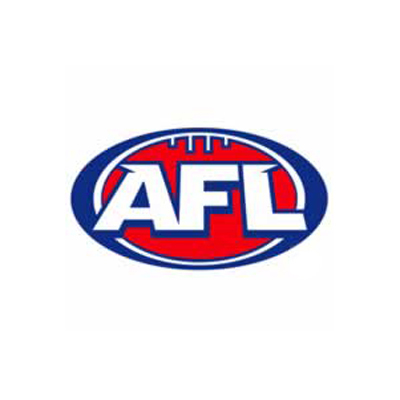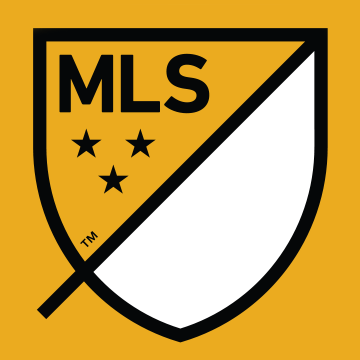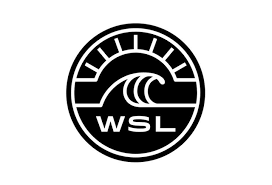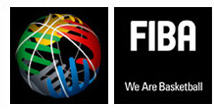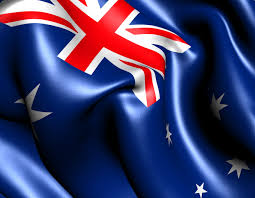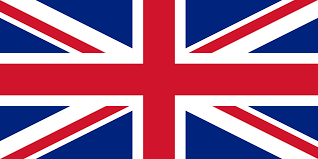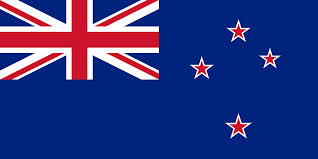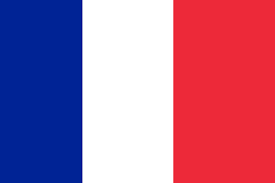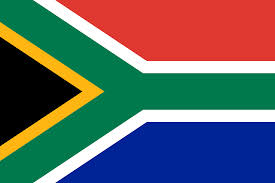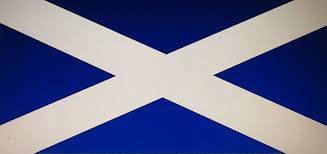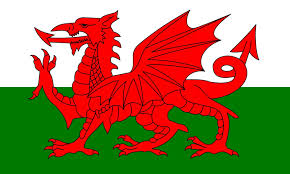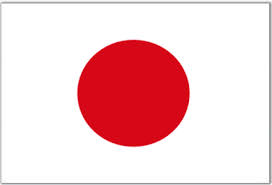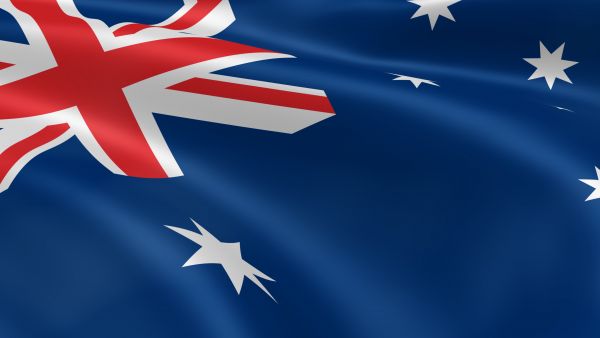Surfer Today.com (International Surfing Association)

Latest News & Results
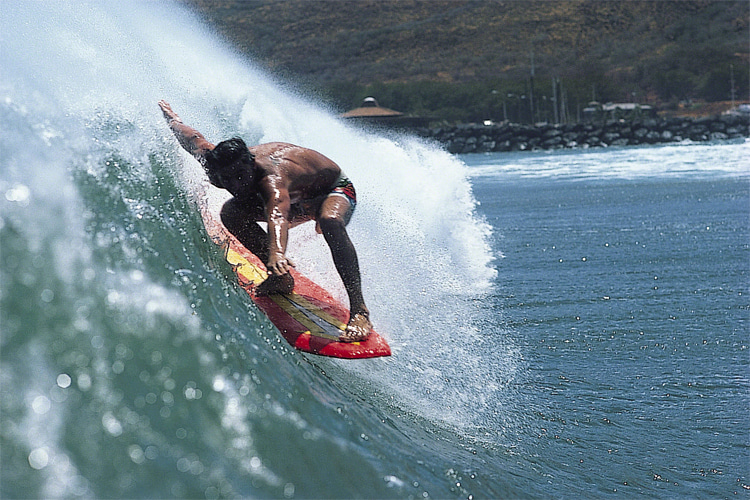
Imagine a wave that behaves like a super-fast cargo train, rushing to reach its destiny at incredible speed. This wave is real. It's called Maalaea.
There are few places in the world where the number of surfers in the water on a given day surpasses the local population.
The census-designated place (CDP) of Mā'alaea in Maui is home to just around 310 people, but its waters can get crowded when south swells hit its beachless shoreline.
Welcome to Maalaea Freight Trains, the nickname for what many believe to be the world's fastest, makeable surfing wave.
The bold claim has solid structures, though.
The legendary surf spot is located in Ma'alaea Bay, on the west coast of Maui, east of Ma'alaea Harbor, in front of a series of condos and resort hotels.
Who would've thought that a world-class right-hand reef break could pop up in a place where you cannot even lay a beach towel?
The secret lies in the stone wall of the harbor that grooms this unlikely wave.
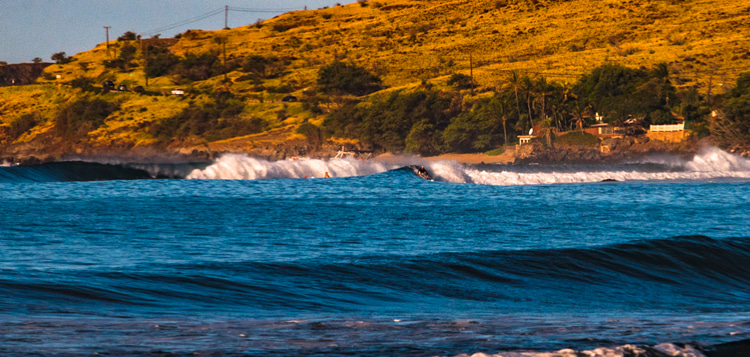
Maui's F1 Surfing Wave
The wave has many names. In the surfing world, it is known as Maalaea, Freight Trains, or Ma'alaea Pipeline.
In the years preceding World War II, Mā'alaea Bay attracted longboard surfers with its infectious waves.
Its central star, Freight Trains, was immediately hailed as one of the fastest rideable waves globally, contingent upon specific conditions for its occurrence.
In the late 1960s, the Valley Isle gained notoriety as a psychedelic hotspot influenced by LSD, an aspect of its culture famously showcased in the Jimi Hendrix concert film "Rainbow Bridge."
The movie, predominantly shot in Haleakalā Crater, also featured surfing clips from Maalaea and was completed just three months before Hendrix's death.
According to surf historian Matt Warshaw, author of "The Encyclopedia of Surfing," "local surfer Joseph 'Buddy Boy' Kaohi was so highly regarded at Maalaea in the late 1960s and early 1970s that the break was sometimes referred to as 'Buddy's Bay.'"
But it was only with the shortboard revolution that the world's fastest right-hander became fully rideable.
Other standout Maalaea riders include Maui residents Analu DePonte, Brad Lewis, Chris Lassen, Chris Vandervoort, Eli Hanneman, Eric Totah, Ian Gentil, Ian Walsh, Imaikalani DeVault, Jackson Bunch Kai Lenny, Kelson Lau, Kevin Sullivan, Lloyd Ishmine, Mark Anderson, Sai Smiley, Tanner Hendrickson, Tom Dosland, Ty Simpson-Kane, Tyler Larronde, and many others.
The break's local bathymetry plays a critical role in the temperamental and machine-like wave's anatomy.
The seabed is made of sharp coral and lava rock, angled at just the right degree, producing the barreling bullet train we occasionally see on videos.
When the surf gets above six feet (1.82 meters), you'll need a lot of self-confidence and experience to handle the tricky and steep take-off.
However, once you drop in, you're sucked into a speedy Formula 1 racetrack that reminds us of Banzai Pipeline but in reverse. Or a blend of Nias and Skeleton Bay.
The right-hand tube ride's length ranges between 150 and 300-plus yards. Not bad, right?
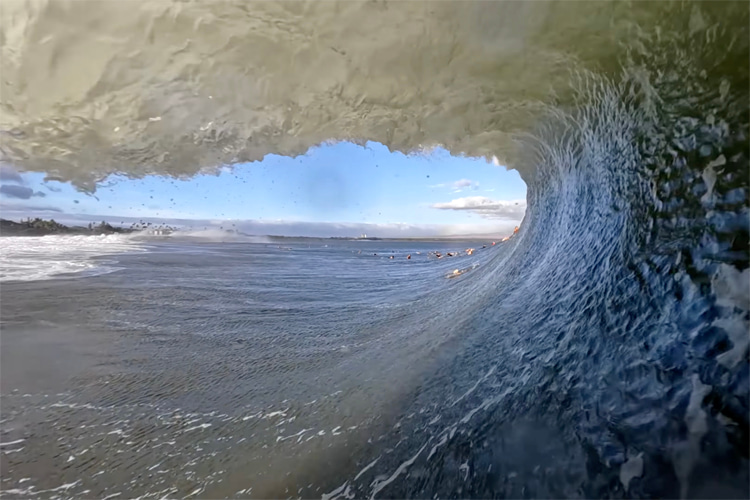
Fickle and Rare
The wave features five sections:
- Off the Wall;
- Impossibles;
- Freight Trains;
- Down the Line;
- Inside Section;
Maalaea Freight Train requires a 3-to-5-foot swell to get things started, ideally on low tide.
Nevertheless, it only reaches firing status with 12-foot-plus waves courtesy of purple-to-black S-SW swells lined up perfectly with an eight-mile-wide gap between the island of Kahoolawe and the southwest tip of Maui and SE winds.
Do not expect this Maui gem to trigger historical sessions every week. Due to its picky requirement, Maalaea only shines in all its glory a handful of times a year.
And that probably explains why no contests have ever been held at this magical surfing arena.
On epic days, the word will spread quickly, meaning the lineup and the take-off zone tickets for this liquid TGV sell fast.
In the 21st century, Maui's Freight Trains delivered superb conditions on two occasions, only - 2005 and 2022.
Maalaea is a fickle, advanced, and expert-only wave. Beware of the shallow reef, rip currents, and uber-hollow waves.
In addition, make sure to make a wise wave selection, as a set could pump over 15 nonstop waves, and getting caught inside might result in a multiple-wave hold-down.
The chances of someone dropping in as a falling lip is about to engulf your F1 car are also high.
The truth is that many get covered, but only a few find the exit. Some actually state that only one-fourth of the waves are completed.
Equipment choice is critical.
You'll need a surfboard that can enter the wave as quickly as possible and doesn't pick up the 20-30 knots offshore wind that often blows strong.
Spring and summer are the best times of the year to get the session of your life at Maalaea Freight Trains.
If it isn't pumping, there will always be Honolua Bay and Jaws/Peahi.
Forever Protected
From time to time, developers have proposed enlarging Maalaea Harbor, which was constructed in 1952.
It was widely believed that any expansion would inevitably jeopardize or destroy the quality of the surf in the area.
In 2002, "Maalaea: A Cry for Help," a documentary highlighting the ongoing conflicts between developers and the Maalaea break, was released.
The good news is that in 2012, after 23 years of intense activism, the iconic Maui wave was preserved.
The victory was declared following the Hawaii Department of Land and Natural Resources and the United States Army Corps of Engineers' decision to abandon plans to extend the harbor's breakwater.
Groups like the Surfrider Foundation have vehemently opposed the project, fearing significant damage to coral reefs and the cherished surf spot.
Authorities cited concerns over high costs, community sentiment, and environmental impacts for suspending the breakwater project.
Watch Maalaea's stunning Freight Trains at their best in the surf movies "Angry Sea" (1963), "Adventures in Paradise" (1982), "Amazing Surf Stories "(1986), and "Maui '99" (2000).
Words by Luís MP | Founder of SurferToday.com
https://www.surfertoday.com/surfing/maalaea-freight-trains-the-worlds-fastest-wave

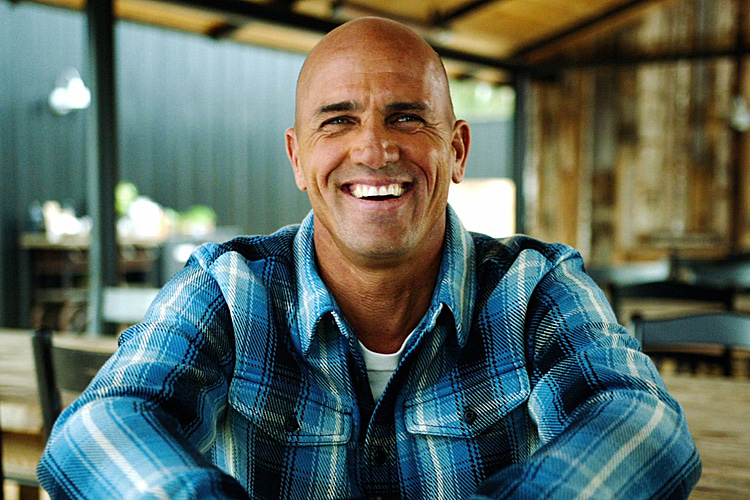
Kelly Slater's entrepreneurial journey has always been relatively kept under the radar, with surfing doing most of his talking. Let's take a look at how the Floridian planned the move from waves to the boardroom.
The world's greatest athletes are usually active businesspeople with multiple entrepreneurial projects in various fields of activity.
Surfers are no different.
The earnings accumulated from years of sponsorship deals and prize money must be channeled to reproductive gains.
Investing in new and established business ventures is a smart way to secure a steady financial future when retirement arrives.
Kelly Slater has been one of the most active professional surfers in embracing risk and generating wealth through company development.
Despite retiring from day-to-day competitive surfing in 2024, his business interests date back to the late 1990s and early 2000s.
Slater's first taste of success out of the water came when he lent his name to Activision's 2002 console video game "Kelly Slater's Pro Surfer."
The title made Kelly Slater a global personal brand anchored on his achievements and accolades as a sportsman.
But the first real risk-taking venture was undoubtedly Kelly Slater Wave Company, into which the pro surfer poured millions of his hard-earned dollars.
The goal was to build a wave pool like nothing the world had ever seen.
Creating an outstanding artificial wave that surfers could ride took years of research and development, i.e., financial resources.
And when the proof of concept was cleared, another $30 million was invested in building the basin in Lemoore, Central California.
In the meantime, Slater created new products and brands, co-founded other small niche businesses, and endorsed a few more.
Here are the list and profiles of Kelly Slater's main business interests.
Kelly Slater Wave Co.
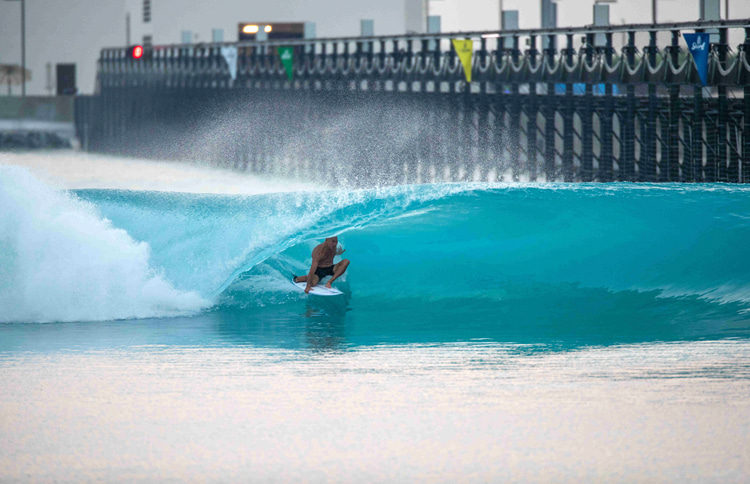
Kelly Slater Wave Co. (KSWC) is perhaps the founder's greatest and most impactful business venture.
It's the company that created the world's first artificial barreling wave.
After years of behind-the-scenes tests and fine-tuning, the 11-time world champion surfer revealed his Surf Ranch to the public in December 2015.
Six months later, the World Surf League (WSL) announced the acquisition of a majority stake in KSWC for an undisclosed sum.
Website: kswaveco.com
Firewire Surfboards
Firewire Surfboards was founded in 2006 by Australian surfboard shaper Nev Hyman, a man who had already created Odyssey Surfboards in 1975.
The company revolutionized the industry by introducing advanced CAD/CAM software in surfboard construction.
Firewire Surfboards also introduced new and more sustainable materials in the manufacturing process, as well as innovative building techniques and technologies.
In 2015, Slater secured 70 percent of the company and became a majority shareholder.
Website: firewiresurfboards.com
Outerknown
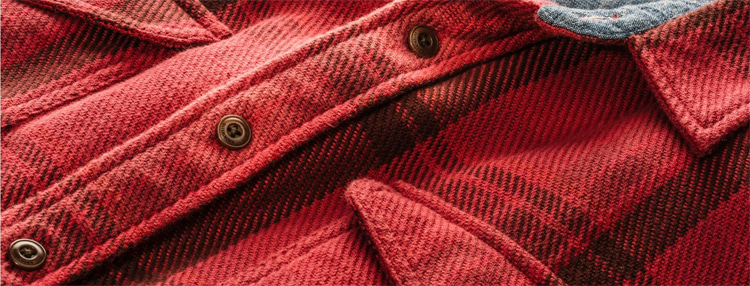
Outerknown is Kelly Slater's adventure into the competitive market of sustainable clothing.
The pro surfer joined forces with creative director John Moore to create an apparel brand committed to responsible sourcing practices and the welfare of everyone they work with, from the farmer to the customer.
The label produces a series of premium wardrobe items using the highest quality and most sustainable materials, resulting in 95 percent of the line being made with organic, Regenerative Organic Certified (ROC), recycled, or regenerated fibers.
As of 2024, Outerknown operates eight retail stores across the US, an online shop, and Outerworn, the resale platform that keeps clothes in circularity rather than in landfills.
Website: outerknown.com
Slater Designs
Slater Designs is Kelly's signature collection of surfboards and surf accessories.
Launched in 2016, it reflects the surfer's personal quiver of boards shaped by world-renowned shapers.
The brand works in conjunction with Firewire Surfboards and designs templates made from sustainable materials, including entropy bio-resin and other less harmful cores.
KLLY
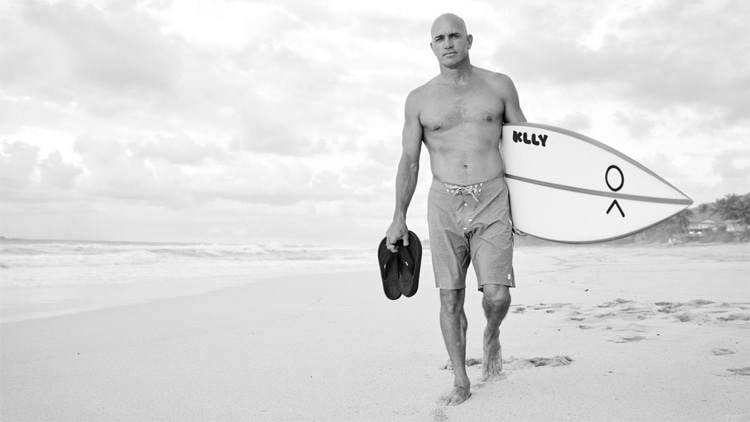
KLLY is a sustainable footwear company launched in 2023 by Kelly Slater.
The brand's flagship is a flip-flop designed for all-day wear, comfort, and outdoor activities.
The design philosophy behind KLLY footwear is deeply rooted in nature, particularly inspired by the relationship between the moon, the ocean, and sea creatures like turtles.
For example, the tread pattern on the sandal is inspired by the shell of a sea turtle, with 13 large plates representing lunar cycles in a year and 28 smaller plates representing the days in each cycle.
The footbed of the sandal is designed to mimic the gravitational pull of the moon on ocean tides, promoting healthy alignment and support.
In terms of materials, KLLY sandals are made using rPET & BLOOM foam derived from algae.
The choice of materials is a commitment to reducing environmental impact, as algae-based materials help combat harmful algae blooms and contribute to restoring and maintaining healthy ecosystems.
Website: klly.com
Endorfins
Endorfins is a range of surfboard fins launched by the Floridian surfer.
Slater reimagined classic fin designs and introduced new construction methods aimed at performing better while minimizing their environmental impact.
One of the key features of Endorfins is their ability to float.
Unlike conventional fins that are often lost or discarded in the ocean, contributing to pollution, Endorfins are designed to remain buoyant, reducing the likelihood of them becoming marine debris.
They offset the carbon footprint of fin production by supporting initiatives such as Sea Trees, which involves conserving kelp forests in California, protecting rainforests in Africa, and planting mangrove trees in Indonesia.
Endorfins are positioned as an alternative to other popular fin systems like FCS II and Futures and are compatible with existing surfboards.
Website: firewiresurfboards.com
Yorks
Yorks is a recycled lumber business based in Nova Scotia, Canada.
The company specializes in repurposing wood sourced from old barns, piers, and other salvaged sources, turning them into new products.
The initiative was sparked by Kelly Slater's involvement, influenced by a friend's deep passion for wood and Slater's own love for surfing.
Yorks plans to use the profits generated from their recycled lumber business to purchase properties in lesser-known surf locations worldwide.
These properties would then be utilized to build eco-friendly houses using their reclaimed materials.
Solento Tequila
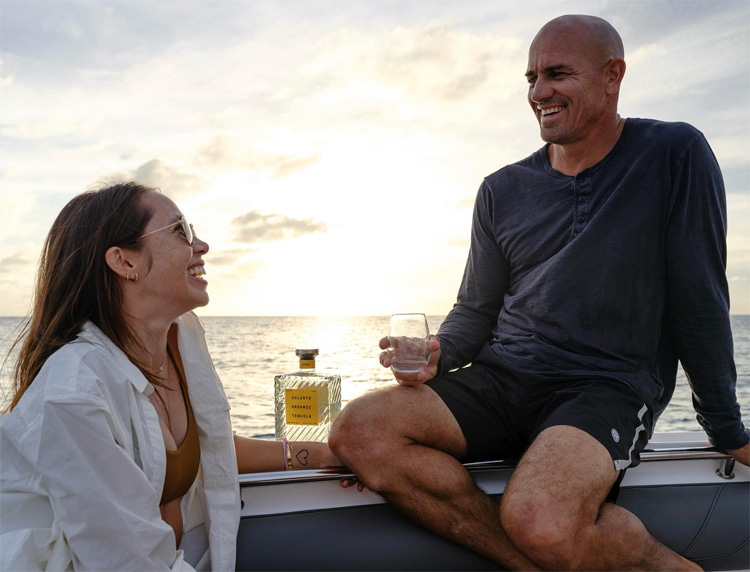
Solento Tequila is an award-winning, USDA-certified organic tequila range founded by surf filmmaker and tequila connoisseur Taylor Steele.
The philosophy behind Solento is rooted in the idea of slowing down and being present, reflected in its name, which is derived from the Spanish translation of "slow sun."
It is free from pesticides, synthetic fertilizers, genetically modified organisms (GMOs), and additives.
Despite not being the average alcoholic drink consumer, Slater endorsed the brand whose process of creating Solento Tequila begins with the slow growth of organic agave under the Mexican sun for seven years.
Harvested meticulously in small batches from a single estate in Amatitán, Jalisco, the agave hearts are then cooked in brick ovens for two days before being pressed to extract their juices.
Fermented and distilled naturally, Solento Tequila emerges with pure flavor, gaining complexity when aged in American oak barrels.
Website: solentotequila.com
Rythmia
Rythmia is a retreat center located in Guanacaste, Costa Rica, for individuals committed to genuine personal change.
It offers a week-long immersive experience and ayahuasca-based comprehensive program to facilitate personal growth and healing.
The program integrates ancient teachings of plant medicine from the Columbian lineage with various complementary modalities to create an optimal environment for healing.
Led by skilled shamans with training in the Columbian lineage, the program includes four ayahuasca ceremonies, complemented by Rev. Michael Beckwith's "The Answer is You" classes, integration workshops, intention-setting sessions, yoga, meditation, dance, and rhythmic breathwork.
Kelly Slater is a member of the Rythmia board of directors.
Website: rythmia.com
Purps
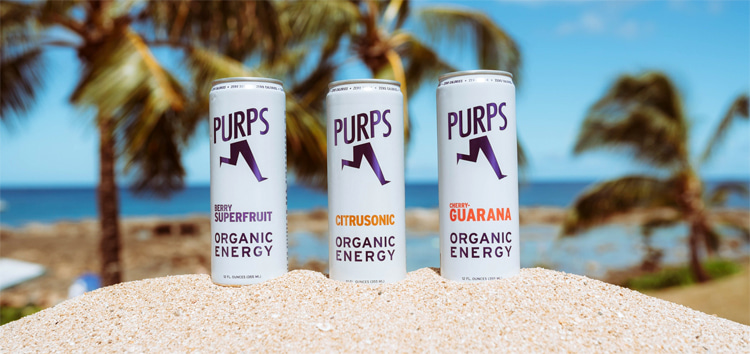
Purps is an organic energy drink created by PM Tenore, founder of RVCA, Dr. Chris Schaumburg, PhD in autoimmune deficiency and inflammation, and Kelly Slater.
It stands out as the only organic energy drink with zero calories and zero sugar, packaged in environmentally friendly packaging.
Formulated to offer a healthy energy boost, Purps Organic Energy utilizes a blend of all plant-based sources of natural caffeine.
The blend includes ingredients such as yerba mate, green tea berry, coffee berry, Indian gooseberry, and pomegranate, providing a natural and sustained energy lift without the drawbacks of sugar or artificial additives.
Purps products are crafted with premium ingredients, prioritizing quality and health. They are free from artificial colors, artificial flavors, and preservatives, ensuring a clean and pure energy drink experience.
Website: purps.com
Words by Luís MP | Founder of SurferToday.com
https://www.surfertoday.com/surfing/the-business-empire-of-kelly-slater

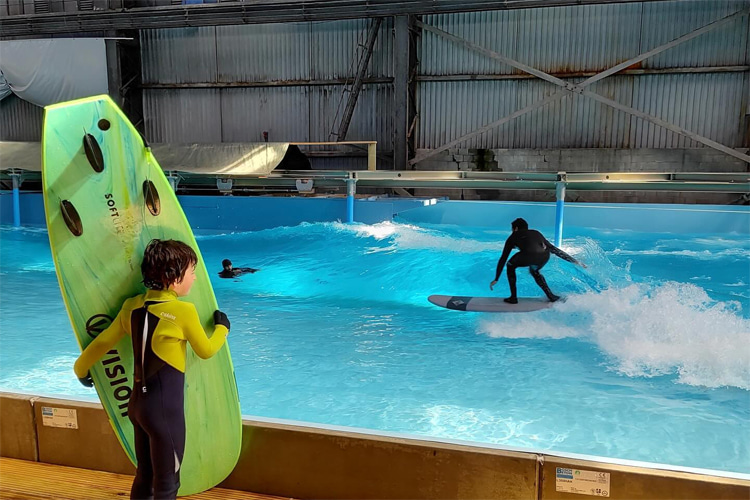
Surpoel, Europe's first indoor wave pool, is already pumping waves. The Dutch structure, powered by 24/7 Waves, has entered the testing stage.
If you've ever played the best-ever surfing game, you'll find resemblances with it.
In "Kelly Slater's Pro Surfer," we are invited to practice our virtual surfing skills at the Wave House, a large hangar turned into a wave pool, before moving to the real waves.
When the console video game was released, riding waves and getting barrels under a ceiling seemed like something you could only do in dreams - or in Japan at the legendary Seagaia Ocean Dome.
However, the unrealistic vision of surfing under a metal roof slowly became a reality.
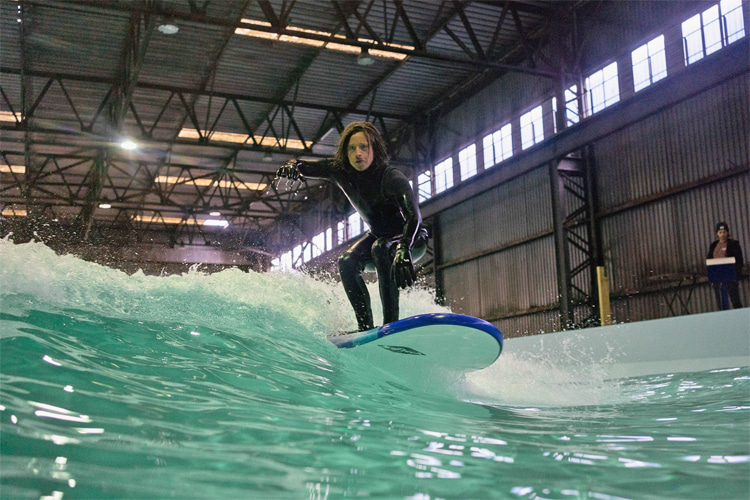
Hangar Surfing
Joeri Fredriks, Jeroen den Otter, and Steven Schmied are three passionate surfers who have dared to try something new.
After securing a physical structure that is half the size of a football pitch and setting up a successful crowdfunding campaign, they got to work.
In Binckhorst, an industrial area of The Hague in the Netherlands, they started installing their proprietary wave-generating technology.
After five years of hard work that involved partnerships with The Hague University of Applied Sciences, Delft University of Technology, and ROC Mondriaan, Surpoel has finally reached the testing phase.
Despite the need for fine-tuning and improvement, this project's potential is undeniable. The trio's ultimate goal is to create the conditions to "surf a perfect wave every day" in the city.
The founders of 24/7, the startup behind Surfpoel, say, "The facility is built from sustainable materials, the vast majority of which can be reused."
"In addition, it is also energy efficient compared to other wave pool techniques in the world."
The wave basin is 70 meters long and 17.5 meters wide.
The Dutch entrepreneurs say the structure produces, in theory, 120 nine-second, 1.5-meter waves per hour.
The first full-scale prototype and proof of concept is now making waves and gathering data to optimize the size and shape of the wave.
The 24/7 Waves team says they can extend the length of the pool to 140 meters and increase the height of the liquid walls up to two meters.
The artificial wave can be adjusted from small breaking waves for beginners to steep waves that can even barrel for advanced and pro surfers.
The Five-Year Loan Financing Model
The project is anchored in a loan campaign that returns 3.5 percent annual interest in five years, plus surfing time on the pool.
By May 2024, over 500 investors joined the urban surfing dream.
The Dutch wave pool technology allows it to be built indoors and outdoors, above or below the ground.
The basin can feature single-wave rectangular pools, double-sided, two-wave rectangular, and circular pools with two or more waves.
24/7 Waves already have potential customers from the United States, Germany, Belgium, and the Netherlands.
Words by Luís MP | Founder of SurferToday.com
https://www.surfertoday.com/surfing/surfpoel-first-european-indoor-wave-pool-enters-testing-stage

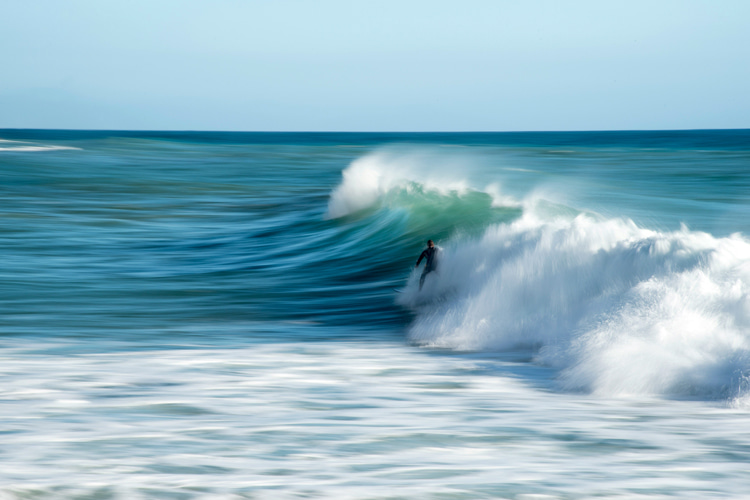
Italy is not the first country you will think of when planning a surf trip around Europe.
However, with its 4,720 miles (7,600 kilometers) of coastline and over 320 rideable surf breaks, there are plenty of fun opportunities popping up when favorable winds and swells align.
The Italian Peninsula is in the heart of the Mediterranean Sea.
This enclosed region depends on the low-pressure fronts from the north, west, or south and enough wind to generate surfable waves around "The Boot."
So, even though consistency is not the best word to characterize Italy's surfing potential, there are certainly plenty of different surf spots capable of producing a few fun gems.
Can you get barreled in an Italian wave? For sure? Are there overhead ramps on offer? Definitely.
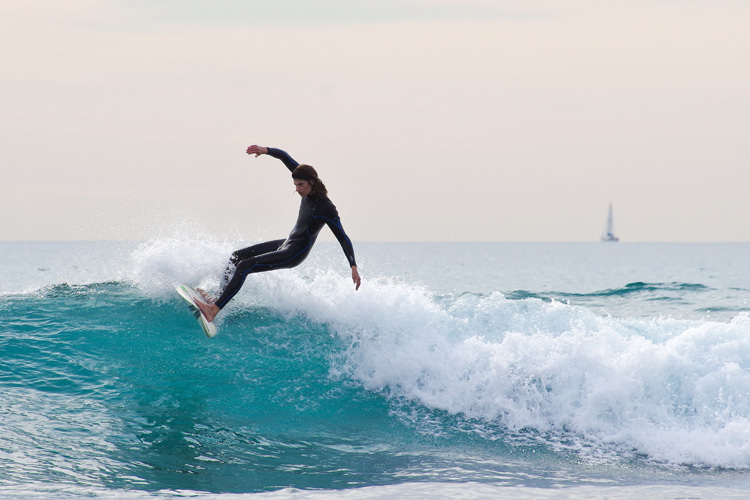
The Italian Northwest
Liguria is probably the most reliable surfing region in Italy.
The crescent-shaped area that goes from San Remo in the west to Viareggio in the East hosts a series of above-average waves along its 175-mile (285-kilometer) coastline.
The secret lies in the geographical position facing the Ligurian Sea and getting the remaining swell energy entering the Strait of Gibraltar, as well as the exposure to the Mistral wind, the driving force for surf in Northern Italy.
Mistral helps build decent swells on the Ligurian reefs by blowing offshore along the Mediterranean coast all the way from NW Italy and across the French coast toward NE Spain.
Ultimately, the region gets around 120 days of surfing per year, even though most could be whipped by onshore winds and small waves.
Water temperatures along the western coast of Italy span from 53-78 °F (12-26 °C).
History
The saga of Italian surfing commences with Peter Troy, the renowned Australian surf explorer, who documented his first ride on an Italian wave in Genova (Liguria) in 1963.
His venturesome exploits, though ahead of their time, failed to resonate with the local populace until the late 1970s and early 1980s, when the inaugural generation of surfers emerged.
Inspired by cult classics like "Big Wednesday" and initial forays to oceanic swells (predominantly in Biarritz), numerous small communities sprang up simultaneously across the peninsula.
Tuscany's Viareggio took center stage, becoming the nucleus where the inaugural club (Italia Wave Surf Team), the premier shop (Natural Surf), and the maiden contests took root.
Leading the charge in this region were Michele and Alessandro Dini, while in Genova, the Marco and Alberto Fracas brothers reveled in the waves of Bogliasco.
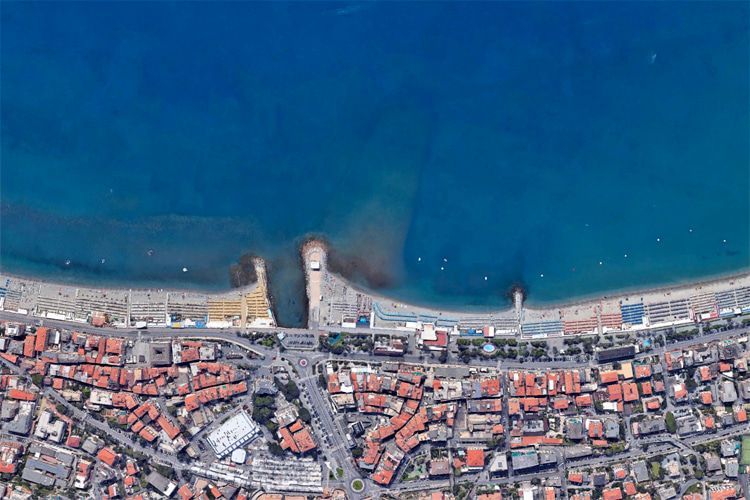
Barreling Waves in the Ligurian Sea
Varazze is one of Italy's most popular surf breaks.
The spot is located 20 miles (35 kilometers) west of Genova in the coastal village with the same name.
It is the focal point of many Italian surfers and French surf travelers.
La Secca, Varazze's main break near Molo Marinai d'Italia, is a powerful A-frame peak that shines with SW and SE and a strong Mistral NW wind.
The right-hander provides a long, workable ride that will take you all the way to the inside; the left-hander provides a shorter yet intense wave-riding experience.
The local shallow human-made reef made of rocks is one of the secrets of this Italian gem.
Interestingly, Varazze's wave quality is the result of one of those random events that suddenly create a wave.
The surf spot's bed of rocky stones was formed by debris inadvertently dumped from the mountain during the works to build a motorway in the 1960s.
But for the barrels to come to life, surfers need windless or offshore wind conditions.
This Italian surfing machine hardly varies, making it sometimes "too perfect." It reminds us of something between a Southern California point break and a southwest of France jetty break.
To get to the peak, you either paddle around it from down the beach or try jumping from the nearby pier on a smaller day.
Varazze is mostly a wave for intermediate and advanced surfers, so assess your experience level before paddling out, especially during wintertime.
The take-off could be challenging, so prepare to hold on to your rail.
If you survive the early seconds of the ride, think about the incoming steep inside section that will want to suck you and your board.
Also, respect the local surfers, as the surf break often gets crowded on average, good and epic days.
In November 2023, Varazze witnessed one of the biggest days of waves of the decade, with double overhead walls of water marching relentlessly toward the shore, courtesy of Storm Ciarán's SW swells.
Although waves break on average once every three days, the best season is Spring.
Words by Luís MP | Founder of SurferToday.com
https://www.surfertoday.com/surfing/varazze-probably-the-best-surfing-wave-in-italy

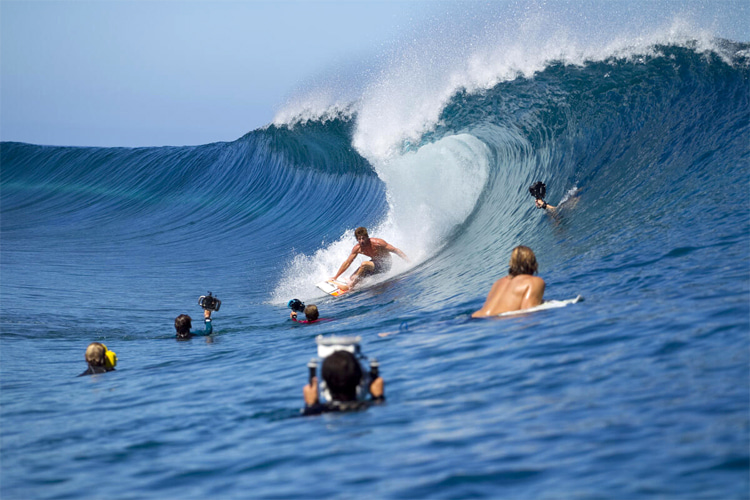
Bruce Irons embarked on a transformative health trial at Beond Ibogaine, a specialized clinic in Cancún, Mexico, where he is exploring the potential of ibogaine-assisted therapy.
Ibogaine is a naturally occurring psychedelic substance derived from the iboga shrub, traditionally used in West African healing rituals.
In recent years, it has gained attention for its potential to treat addiction and mental health issues like depression, anxiety, and PTSD.
Irons' decision to undergo this follows a long battle with mental health issues, fueled by the tragic loss of his brother and three-time world champion, Andy Irons, who also battled inner demons.
The Beyond Ibogaine program combines ibogaine treatment with various "adjunct therapies," including cold therapy, meditation, sound healing, art therapy, movement, and massage.
This holistic approach aims to support patients as they work through the powerful and introspective experience induced by ibogaine.
In a video message, Irons described the Mexican clinic as a place of "open arms" and understanding, as opposed to his perception of traditional Western medicine and rehab facilities.
The winner of the 2001 Pipe Masters and the 2004 Eddie Aikau Invitational underlined the clinic's success rates and the genuine care provided by the staff.
The will to get better and overcome his mental health issues was inspired by his brother Andy.
"My brother was a world champion. He's the baddest motherf***er that ever lived, and I'm doing this for him and all my other fallen brothers and friends who died," says Irons in the video.
Psychedelic Plant Medicine Against Mental Health Issues
Both ups and downs and mental health struggles, including depression and drug use, have punctuated Bruce's life.
In the video released by the Mexican health treatment center, the Hawaiian highlights the effectiveness of the ibogaine treatment provided, which allows individuals to reach into their minds and visions, facilitating profound personal insights and growth.
Bruce stresses the importance of putting in the work and being honest with oneself during the healing process he chose to embrace.
"It doesn't matter what your current state is, how bad it is, how worse it is," added the pro surfer.
"It always can get worse, and there's always someone that's looking a little shittier, but when I came to this place, it's basically with open arms, no judgment, resentment, nothing."
It's important to note that ibogaine is a powerful drug with potential risks, and its use remains controversial.
It is currently illegal to use therapeutically in the United States.
Bruce Irons, 44, feels he can still shine in Hawaii's most challenging waves.
"I still feel like I got one win in me left. Or two. One more Pipe Masters, one more Eddie. Let's do it. I'm f***ing going for it."
Words by Luís MP | Founder of SurferToday.com
https://www.surfertoday.com/surfing/bruce-irons-battles-mental-health-issues-with-psychedelic-therapy

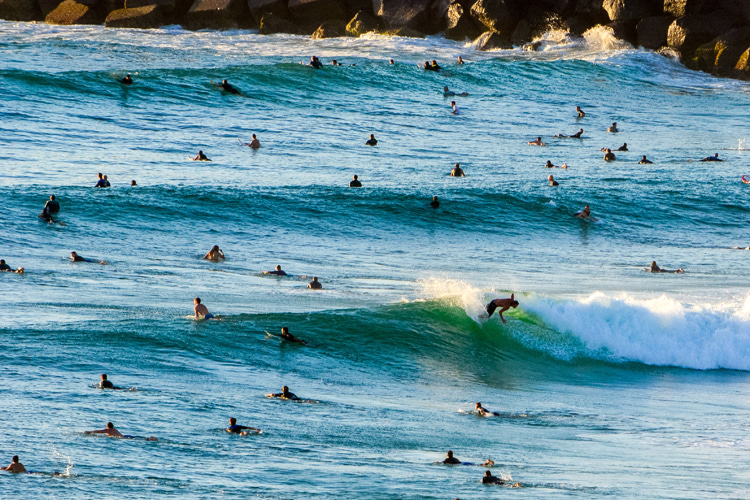
Life changes when you start working. And so does your surfing.
Most of the freedom and flexible time schedules you had before you became a grown-up adult with responsibilities and bills to pay ends or gets seriously axed when you get your first job.
The days when you could put on a wetsuit and just paddle out when the surf's great slowly vanish as you progress through your 20s and 30s.
Although this is not an inevitable scenario for every surfer out there, it's the most common one.
So, 99 percent of all hard-working recreational surfers end up with two days to shred and get their golden share of waves.
We end up in the so-called weekend warrior basket, the silent majority that surf media professionals, influencers, and wanna-be pro surfers often mock.
And then, if you commit the ultimate sin of starting a family, things get even worse for a while - weekends turn into months and years.
Some longtime surfers even lose the will to get in the water and enjoy the pleasures of catching a few "just like in the old times."
Passion fades away, and aging doesn't help either.
So, if Saturday and Sunday are the only days left for a quick surf escape, we try to make it work, come rain or come shine.
One of the best ways to transform these golden opportunities into pleasurable sessions is by choosing a consistent break, ideally close to home.
The problem is that we all follow the same rationale.
Consequently, beaches known for their average-to-good conditions all year round get crowded, if not impossibly crowded.
And then, on top of that, there's the uncontrolled surf school army, taking over the battlefield from the early hours of the morning until the sun sets and darkness kicks in.
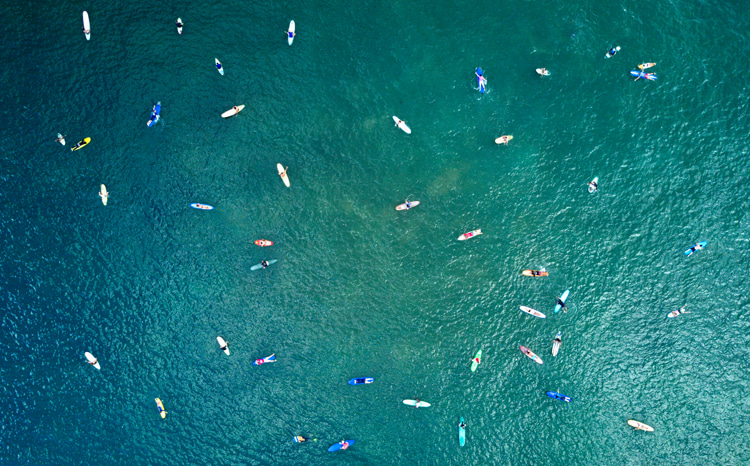
Pain Point Reached
One of these Saturdays, I exercised my weekend warrior right to ride a few good waves for an hour.
I tried to time the tides and be at the beach as early as a working man in his 40s could.
I guess I was ready to get wet before 9 in the morning.
By the time I was paddling out with my hair still dry, there were already a few partners in crime looking like they'd had their weekly share of fun.
No worries. The vibes were good.
However, in less than half an hour, I was already surrounded by dozens - literally - of first-timers wearing their multi-colored jerseys, each representing a surf school business.
Luck is also not on my side.
My home break is one of the busiest in Europe, located within bike, metro, or car distance from one of the most en-vogue tourist destinations in the Old Continent of the last decade.
Despite being a long beach break with multiple peaks that pump around 300 days of surfing a year, its resources are not infinite.
Moreover, space is limited.
And if you think you can teach beginner surfers the basic rules of surf etiquette, forget it.
They will not look left and right before paddling into a perfect wave or a close-out guillotine.
They don't care, and instructors often follow the pattern.
Suddenly, I was encircled by colored jerseys, soft-top surfboards, and all sorts of in-between set chats.
The word "surrounded" could fit in the concept of vital space a surfer needs to exercise their art.
But this wasn't the case. I had surf pupils within a board's reach.
I had to plan how to turn the board around to catch a wave. And when I was successful, there was another challenge ahead - to complete a ride.
I am not one of those who whistle or yell at others to ensure my priority is respected.
In case of imminent danger, I respectfully emit a warning - usually, "Attention!" - to avoid disaster, injuries, and surfboard dings.
So, every time I caught a wave, I would have a drop-in incident, putting an end to an average ride.
And then, they smile back at you while still riding their boards prone toward the beach.
One time is OK; twice could happen. But three, four, and five times is a pattern.
At some point, I decided to call it quits and paddled in.
As soon I was taking off my leash my leash, I looked back at the lineup and realized this wasn't surfing.
The peak I had chosen to release my weekly stress had around 20-30 people thinking they were having fun.
They were all six feet apart, probably thinking they were having the time of their lives.
I immediately told myself I would not come back here again on a weekend.
This was not surfing; this was not fun. I actually didn't even know what that was.
Was it masochism? The need to belong to a cool tribe? A photo-op for social media?
How can they feel they're experiencing the exhilarating rush of walking on water when there's so much noise and many boards around them?
As I walked up the beach, I felt equally frustrated and depressed.
Getting Away
I am one of those who believe the world would be a better place if more people surfed.
I am genuinely convinced my beloved pastime improves people's lives.
But I cannot deny that getting surfing into the mainstream and a wider audience is simultaneously killing the experience for everyone.
Is there a balance between these apparently opposing worlds? Where do you draw the line between healthy and enjoyable lineups and promoting surfing and its virtues?
In the past, I adopted the rule that tells my inner self to choose an average peak that is often less crowded instead of a quality wave where 100 weekend warriors are jockeying for position.
But the latest lesson learned is that I do have to drive away from my home break and try my luck in alternative spots where there's barely a soul breathing.
Until my new secret spot gets crowded, and I stop surfing forever. Is this my destiny, or am I getting old and picky?
Words by Luís MP | Founder of SurferToday.com
https://www.surfertoday.com/surfing/the-battle-for-waves-in-overcrowded-surf-breaks

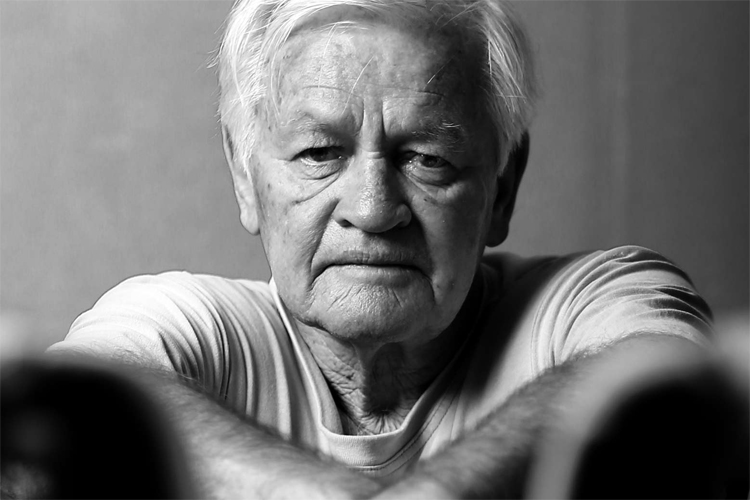
Geoff McCoy, one of the world's most innovative and creative surfboard shapers, passed away at home in Byron Bay, Australia, at the age of 79 after complications following a heart attack.
The pioneer of the shortboard revolution was born in 1944 in Gosford, New South Wales.
As a youngster, the son of a farmer and the Killcare Surf Club captain was a talented horseman.
Geoff started surfing at age 14 during his school holidays at Avoca Beach.
He shaped his first boards at 17 for Bennett Surfboards and Keyo Surfboards after concluding a five-year apprenticeship in wood and metal pattern making.
He was also the co-founder of M&M Surfboards.
In the 1970s, the Australian set up his own business, McCoy Surfboards, in Brookvale, a Sydney suburb.
Ray Richards, the father of world surfing champion Mark Richards, encouraged him to do so and ordered the shaper's first ten creations.
In just half a year, the McCoy factory produced 65 boards weekly.
It marked a vibrant era as Geoff crafted boards for numerous top surfers and embarked on his inaugural journey to Hawaii.
In 1978, Geoff dedicated a year to California, establishing McCoy USA and collaborating with Jeff Hakman on design innovations.
By then, McCoy had shifted his factory to Avoca Beach on the NSW Central Coast, laying the foundation for the expanding McCoy empire across Japan, the USA, and Hawaii.
Geoff's instinctive desire to experiment and try new things got him into the world of twin-fin surfboards, making him one of the first Aussies to shape them.
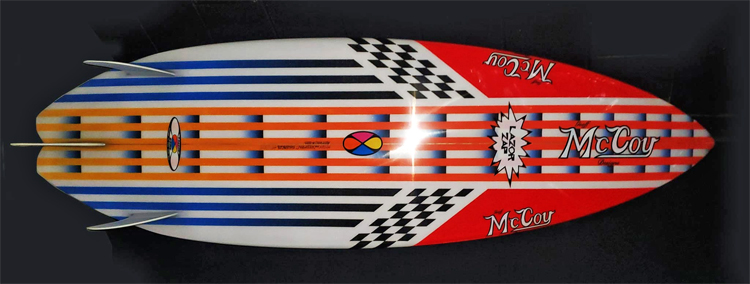
The Lazor Zap
However, what really changed for the NSW surfer-shaper was the famous "Lazor Zap," a surfboard model with a steep rocker and a sharp nose.
The board allowed surfers to get more vertical, engage in tighter top-to-bottom surf lines, and take more risks while performing radical maneuvers.
According to surf historian Matt Warshaw, the "Lazor Zap" allowed surfers to "move the board's trimming sweet spot - usually a foot or so ahead of where the rider stands while turning - back toward the tail section so that, in theory, the surfer would not have to move their feet."
The magical model helped team rider Cheyne Horan lock in two runner-up finishes in the 1981 and 1981 ASP World Tour.
Here's how Geoff McCoy described his iconic template:
"The concept of the 'Lazor Zap' is based on my energy theory, which explains how energy turns into wave formation and how objects react with those formations."
"The original 'Lazor Zap' was designed with short arc, reactive high-powered surfing in mind. The surfer was able to stand in one position, not having to move their feet to perform their maneuvers and this is exactly how the boards performed."
"The pulled nose allowed the board to elevate very quickly as it reduced the length of rail being used when the board is turning."
"In turn, this allowed for more maneuvers to be performed while the surfer was standing in a fixed position on the wide thick supportive tail which generates greater pressure and easier reaction."
"The advantages were many - easier to paddle, stand in one position to ride the wave, quicker reaction from the extra volume, easier turning from less resistance, and ability to surf at a faster speed."
"In effect, everything required from them, the 'Lazor Zap' designs delivered at all levels of performance."
An Inspiring Surfboard Craftsman
McCoy's lineup also featured other groundbreaking designs, such as the "Nugget," "Quazor Zip," and "Astron Zot," each presenting its distinct features and riding opportunities.
Simon Anderson's thruster revolution soon eclipsed McCoy's avant-garde models and designs sold via Lost and Channel Islands.
But the mentor of the three-fin setup would Call Geoff one of the five inspiring figures behind the thruster.
Meanwhile, a business manager hired by Geoff methodically accumulated debt for McCoy.
The shaper became aware of this when a longstanding associate inquired about outstanding payments.
Geoff contacted the manager from Sydney, only to find the accounts wiped from the computer upon his return to the Avoca factory.
He had lost around 500,000 dollars.
Faced with bankruptcy or receivership, bankruptcy was unthinkable for Geoff, who valued honor and integrity.
Reluctantly, he placed the flourishing business under receivership, liquidating assets to settle debts in 1984.
McCoy never stopped shaping boards - in Hawaii, Tweed Heads, and Byron Bay - or inspiring craftspeople worldwide to rethink his greatest models.
The man who spread the tear-drop-shaped surfboard smoothly blended philosophy, pragmatism, and technically superior foam-mowing skills into his out-of-the-box designs.
In 2018, Geoff highlighted the surfers who profoundly influenced his shaping philosophy: Gerry Lopez for hold and release, Midget Farrelly for the outline, and Nat Young for rails.
McCoy might have left us, but his rideable legacy lives.
Words by Luís MP | Founder of SurferToday.com
https://www.surfertoday.com/surfing/geoff-mccoy-the-father-of-the-lazor-zap-passes-away

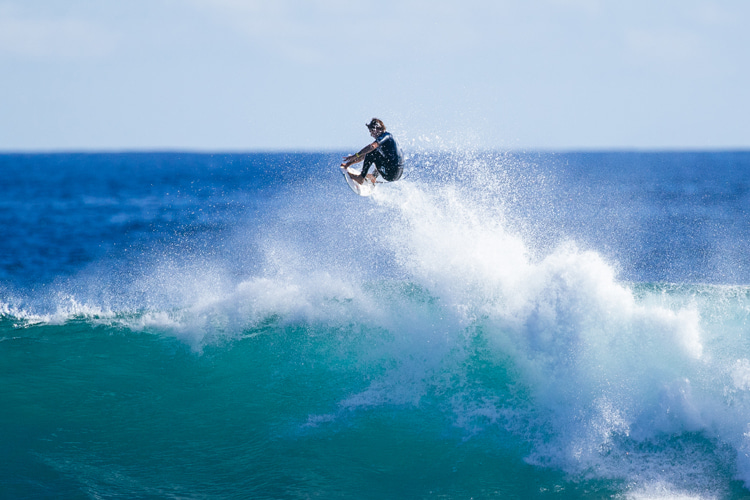
Jack Robinson and Gabriela Bryan have taken out the 2024 Margaret River Pro.
In a full day of competition that ran 18 heats, Bryan and Robinson took down a stacked field in six-to-eight-foot waves at Margaret River's Main Break.
As the final event before the mid-season cut, the surfers left in the draw had one last opportunity to continue through to the back half of the 2024 CT season.
Today's high-pressured heats confirmed the final list of competitors who made and missed the mid-season cut.
Gabriela Bryan Claims Maiden CT Victory
Coming into Margaret River Pro, Gabriela Bryan was sitting in 10th place on the rankings and in desperate need of her best result of the year.
A standout at Margaret River, Bryan has made the final at this location before to save her place on Tour with a career-best runner-up finish in her rookie season.
The 22-year-old's path to the Final was a rocky one, with plenty of close results seeing her edge out her opponents, Costa Rica's Brisa Hennessy and Australia's India Robinson.
Bryan saved her best surfing for last against 2024 CT Rookie Sawyer Lindblad (USA) in the Final, where she posted her best heat total of the week, a 15.93 (out of a possible 20), to claim her maiden CT victory and move up to No. 5 on the world rankings.
"I don't even know what to say. I'm so happy right now," Bryan said.
"It's been a crazy day, crazy week, crazy month. I'm so happy to get this win and proud to do it when my back was against the wall. I couldn't do this alone, though. My mom, my dad, my brother, and my sister support me so much."
"Seabass [Sebastian Zietz] has supported me so much. There are so many people at home, and I hope I've made them all proud. This is insane, and I don't even know if it's sunk in yet."
The women's Final saw eventual winner and 2022 Western Australia Margaret River Pro runner-up Bryan take on rookie Lindblad on a day that has once again seen the next generation of female competitors raise the bar.
For the majority of the 35-minute matchup, both women held mid-range heat totals without separating Linblad's vertical backhand approach from Bryan's frontside power hacks.
Then, with less than five minutes left, Bryan found the biggest wave of the set and laid down a huge frontside carve, then finished with a super late, critical rebound to earn an excellent 8.10 (out of a possible 10) to take the win.
"I was coming into this event under the cut, and now I'm No. 5, which makes a big difference," continued Bryan.
"It's just reassuring knowing my surfing belongs on Tour. I'm so happy we got good waves today."
"Last year, I was eliminated from this event and relied on things going my way to make the cut, so it was so good to do it myself and do what I needed to do."
"All the girls put on such a good show today. When I kicked out of that wave, I knew it was sent to me by someone - with those dolphins riding it - it was amazing."
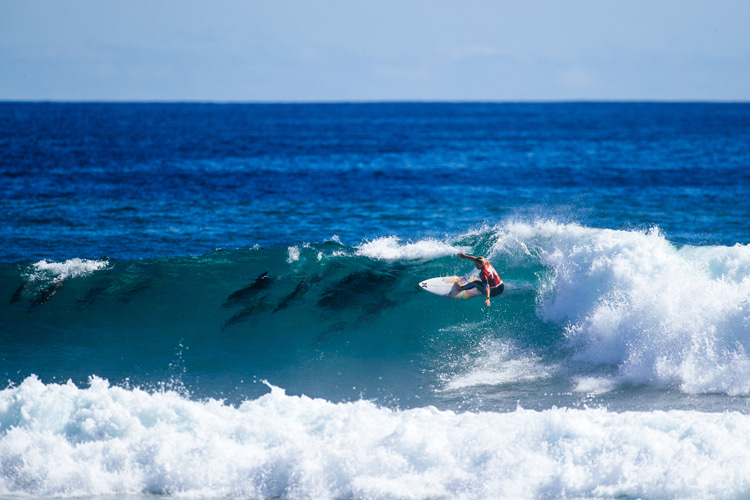
Robinson Earns Second CT Victory at Margaret River
After winning the 2022 Western Australia Margaret River Pro, a knee injury early last season robbed Jack Robinson of defending the title at his home break.
This year saw Robinson get his opportunity, and after an early exit at Bells Beach, the young Australian World Title hopeful looked destined for the Final from his performances today.
Robinson built through the day and, in the Final against John John Florence, posted the second-highest heat total of the event to claim his second win in front of his hometown crowd, friends, and family.
"I missed last year and went through so much to get back and get through that injury, so I felt like this year I was defending my title," Robinson said.
"I'm feeling good. That's the final I wanted, and I wanted to throw everything at it. It's always fun surfing against John."
"We will have many more heats in the future, I'm sure. What a day. I'm super humbled to be here and win at my home, and I'm so grateful for this moment."
The men's Final saw local boy Robinson come up against Main Break standout Florence in a matchup of the two event standouts.
Florence looked to be the man to beat coming in, but Robinson had other ideas, posting a 9.10 for three huge carves on one of the biggest waves of the event, then backing it up with an 8.17 for a massive frontside straight air with three turns to complete the wave.
Robinson's 17.27 heat total (out of a possible 20) was the second-highest of the event and left Florence needing a Perfect 10 to take the lead.
Florence posted an 8.10 to lower the requirement but couldn't find another set wave, leaving Robinson to take the win and equal Florence with two Main Break victories in what was one of the heats of the event.
With this being his second CT win of the year, Robinson moves to second on the rankings heading into Tahiti, where he is the defending event winner.
"John John fires me so much, and I always look forward to heats with him," Robinson continued.
"There's no one else I'd rather final with than John. Watching him out here inspired me so much. He set the benchmark. It's not just me who won; it's everyone who supports me."
"It's an incredible moment. To come back here after traveling all year is special. It's my home, and it's the best place in the world. And I'm grateful to be here right now."
Last Mid-Season Cut Qualifiers
Sally Fitzgibbons, the 15-year CT veteran, needed to win the entire event to save herself from the cut.
In a battle with 2024 CT rookie Sawyer Lindblad, the two competitors played a patient game, with former Margaret River winner Fitzgibbons holding the advantage with only two waves surfed.
With everything on the line, Lindblad threw everything at a medium set with only seconds remaining to earn a 5.50 and the win by just 0.50 of a point.
For Fitzgibbons, it's the second consecutive year she will be forced to return to the Challenger Series, a tour she dominated in 2023.
Bryan won her heat against India Robinson in the first Quarterfinal to make the cut and secure her position on the Tour for her third straight season.
Robinson, who needed to win the entire event to avoid relegation, put up a strong fight, but she fell less than 2 points shy in the Main Break conditions.
With a massive comeback to start the day in Heat 5 of the men's Round of 16, Moniz saved himself from the cut in the dying minutes of his heat against World No. 2 Ethan Ewing.
With time escaping the Hawaiian, he had one final opportunity that paid off with an excellent 8.17 and the win.
Moniz went on to face Robinson, where the close matchup saw the West Australian get the win with a narrow 0.63-point advantage.
Brazilian Caio Ibelli was unable to take down eventual Quarterfinalist Smith.
His loss in the Round of 16, Heat 6, means that he missed the cut, while the result also cleared the way for Connor O'Leary (JPN) to qualify.
Ibelli will head back to the Challenger Series, which kicks off in exactly one week at the Bonsoy Gold Coast Pro at the famed Snapper Rocks.
Joining Ibelli at Snapper will be Samuel Pupo (BRA) after his loss to Florence in the first Quarterfinal.
An excellent performance from Florence, with a 16.26 combined score, was too much for Pupo to defeat with a 14.17.
Pupo relegated his older brother in the Round of 16, and they'll now do battle to requalify for the Tour together via the Challenger Series.
Pupo's also loss provided the opening and confirmation for Yago Dora to be the final men's competitor to clear the mid-season cut.
2024 Margaret River Pro | Finals
Women
- Gabriela Bryan (HAW) 15.93
- Sawyer Lindblad (USA) 13.94
Men
- Jack Robinson (AUS) 17.27
- John John Florence (HAW) 16.04
Made the Cut
Men
- Griffin Colapinto
- Jack Robinson
- John John Florence
- Ethan Ewing
- Jordy Smith
- Jake Marshall
- Barron Mamiya
- Cole Houshmand
- Kanoa Igarashi
- Liam O'Brien
- Imaikalani deVault
- Crosby Colapinto
- Seth Moniz
- Rio Waida
- Ramzi Boukhiam
- Italo Ferreira
- Leonardo Fioravanti
- Ryan Callinan
- Gabriel Medina
- Matthew McGillivray
- Connor O'Leary
- Yago Dora
Relegated
- Samuel Pupo
- Ian Gentil
- Caio Ibelli
- Miguel Pupo
- Kade Matson
- Jacob Willcox
- Frederico Morais
- Callum Robson
- Eli Hanneman
- Kelly Slater
- Deivid Silva
- Joao Chianca
- Filipe Toledo
Women
- Caitlin Simmers
- Johanne Defay
- Molly Picklum
- Brisa Hennessy
- Gabriela Bryan
- Caroline Marks
- Bettylou Sakura Johnson
- Tyler Wright
- Tatiana Weston-Webb
- Sawyer Lindblad
Relegated
- Lakey Peterson
- Luana Silva
- Sally Fitzgibbons
- Isabella Nichols
- India Robinson
- Alyssa Spencer
- Sophie McCulloch
- Carissa Moore
https://www.surfertoday.com/surfing/jack-robinson-and-gabriela-bryan-win-2024-margaret-river-pro

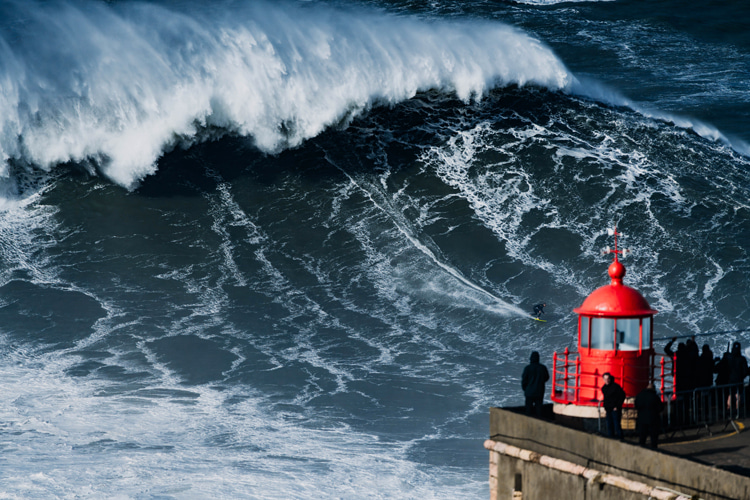
Big wave surfing is an industry with an industry.
The relentless chase for world records translates into prize money and sponsorship deals.
Athletes have been pushing their limits and putting their lives on the line to ride bigger and heavier waves.
Top athletes now work with multidisciplinary teams involving personal trainers, psychologists, nutritionists, photo and videographers, and public relations professionals.
This 360-degree approach brings world-renowned big riders closer to their goal of holding the record for the largest wave ever surfed.
Sebastian Steudtner is one of them.
The German holds the coveted Guinness World Record trophy validated by the World Surf League.
But the 2023/2024 winter season was particularly rich in XXL swells and potentially world record-breaking feats.
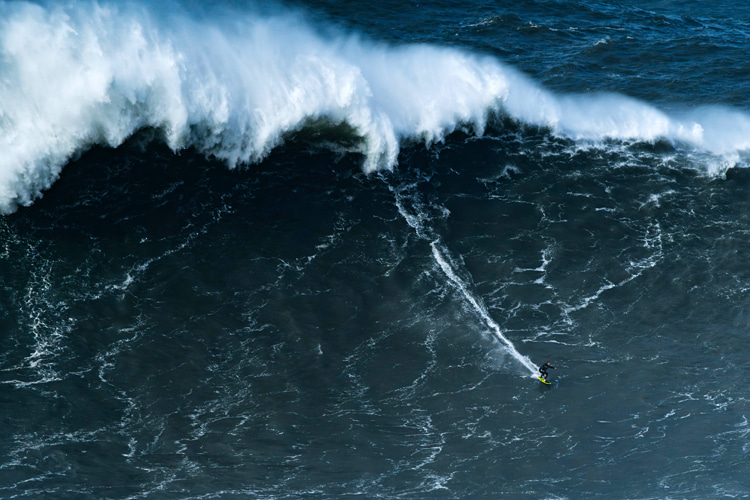
Drones to Measure Wave Height
So, because the best defense is the attack, Steudtner leveraged "state-of-the-art drone technology" developed by Porsche Engineering to measure one of his best recent rides at Nazaré.
The drone prototype from the joint technology project between Team Steudtner and Porsche Engineering was used during this winter's XXL swell.
According to the German team, the device determines the height of waves quickly and precisely.
The prototype is equipped with cameras, control units, and storage devices.
In addition, sensors are used in vehicle development to support modern driver assistance systems.
The drone can measure all areas of the wave and the surfer within a radius of about 100 meters.
"We are very pleased to have created an innovative solution that can advance the sport of surfing," says Marcus Schmelz, Project Manager at Porsche Engineering.
"It was a challenge to develop a drone that can measure not only the height of the waves but is also capable of tracking the surfer within the radius throughout the entire wave ride."
Porsche Engineering's drone measured Sebastian's wave at Nazaré at 93.73 feet (28.57 meters). The wave was caught and ridden on February 24, 2024.
The current world record, also held by Steudtner, is 86.4 feet (26.21 meters), which was achieved at Nazaré in 2020.
The current official WSL measurement model uses video footage and still images to determine wave height.
"We are open to sharing our technical insights from the drone development with official experts," adds Schmelz.
"Our goal is to further increase transparency in big wave surfing and to provide accurate measurement data more quickly."
Porsche's drone is not the first to fly over waves and measure them.
In 2020, Teddy Allen and Milan Curcic created Henet Wave, a similar, portable unmanned aerial vehicle (UAV) that works as an aerial surf buoy.
The device was tested in 2022 and has been continuously updated.
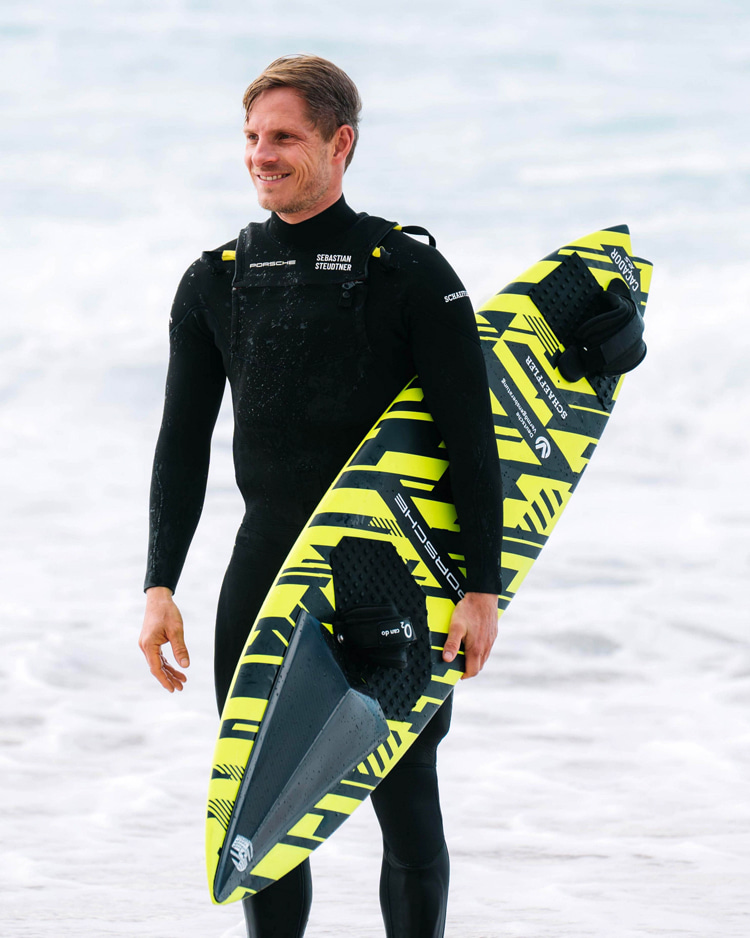
Mission Wave Alpha
Sebastian Steudtner's entourage is one of the strongest in the field.
The German is backed up by several multinational corporations, including Porsche, Porsche Engineering, Schaeffler, O2 Germany, Deutsche Vermögensberatung, X-BIONIC, and others.
He recently set up Mission Wave Alpha, a project that aims to get Steudtner surfing waves twice the size of the current world record, i.e., 130-160 feet (40-50 meters).
These brands are helping him push the sport to the next level on all fronts, from water safety to board materials and design.
Over the past three years, Steudtner, in partnership with Porsche Engineering and Schaeffler, has developed and optimized new surfboard technology to get him surfing the biggest waves possible.
For instance, to reduce water and air resistance, a fundamental variable in surfing, the surfer and his tech team used the latest simulation methods and wind tunnel validations.
As a result, with the new board "Caçador RS," Steudtner says he can now reach speeds of up to 100 kilometers per hour, compared to the previous 80 kilometers per hour.
Higher speed is critical to riding larger waves because the taller a wave is, the faster the surfer must be so that it doesn't overrun him.
Now, this speed advantage enabled Steudtner to ride the potential next record wave.
"I am very proud to be able to bring big wave surfing to the next level through the development of safety and technology and by believing in my dream," concludes Sebastian Steudtner.
"Together with my team, which is driven by its unique 'can do' mindset to define possible in big-wave surfing, we were able to accomplish this mission."
The race for the world's largest wave ever surfed is on, with Lucas "Chumbo" Chianca also claiming a potential record in Praia do Norte, Nazaré, Portugal.
Words by Luís MP | Founder of SurferToday.com
https://www.surfertoday.com/surfing/sebastian-steudtner-and-porsche-develop-wave-height-measurement-drone

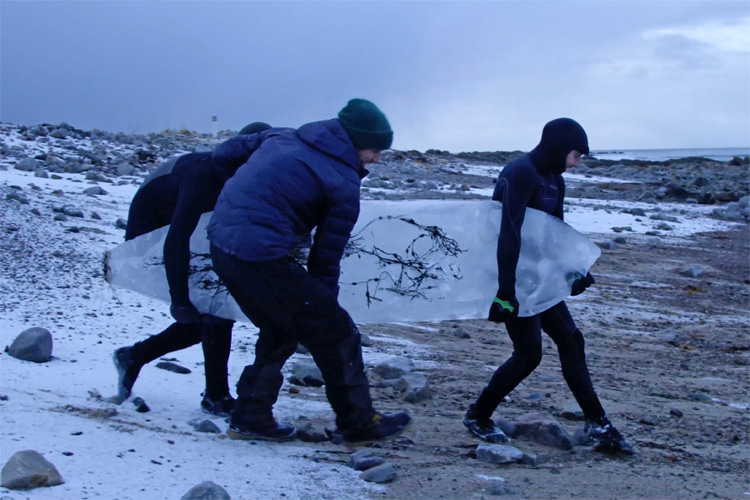
Is it possible to shape a surfboard out of ice? And if you make it a reality, can you surf it?
They're probably the world's most sustainable surfboards, made from the same core of waves - water.
The physics of surfboards and surfing tell us that gravity and buoyancy play fundamental roles in moving the rideable surface across the wave.
These two forces only need a stable, relatively wide, and long stiff material to propel a human over the water.
One of the first to come up with the idea of a surfboard made of frozen water was Conn Bertish, a surfer, artist, and ocean protection activist, who crafted a life-sized surfboard completely out of ice in 2009.
Bertish spent two days sculpting the ice board in a specialized fridge in Cape Town, South Africa.
Afterward, the board was transported in two pieces to Depasco Café, where it was showcased to the public as part of the Wavescapes Surf Art Exhibition.
The goal was to highlight the impact of global warming on our oceans and the rapid melting of glaciers and ice caps worldwide.
So, if ice is solid and floats, why can't it be shaped and turned into a real rideable surfboard?
Well, that was exactly what Nordics and Scandinavians thought when they first created these innovative surf craft.
If there's a resource they can harvest nearly infinite quantities, it is ice.
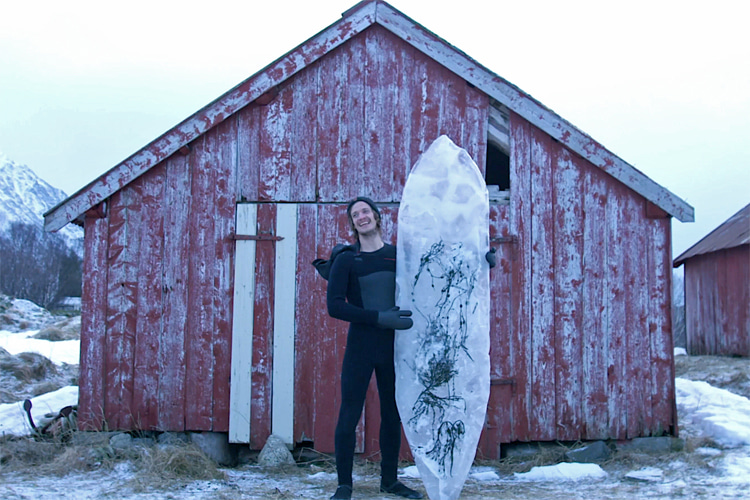
The Pioneering Norwegian Experiment
In 2019, Lofoten-based filmmaker Inge Wegge shot "Ice Edge," a short movie about a Norwegian collective trying to shape surfboards made of ice.
The team included seasoned surfers, a professional ice sculptor, and a local shaper.
It was a trial-and-error process, as different shaping techniques had to be tested, and carving ice blocks above the Arctic Circle is not something anyone can do.
Nothing was ruled out: longer and shorter templates, finless and non-finless setups, the use of sand to increase grip, and even embedded LED lights.
Soon, they realized they needed around 20-30 frozen surfboards and a boat to carry them to the lineup and town surfers into the waves.
All of this is in -10 °C of air temperature that often feels like -25 °C due to wind.
At first, they tried cutting ice from frozen lakes, but it didn't work.
Then they made molds from plastic and wood, filled them with fresh water, added seaweed for grip, and some other things for fun.
They put the boards in a room at -25 °C for two days in a fishery before testing them in the waves.
They tried out the boards for four days, carrying heavy 70-kilogram creations to the water.
The boards lasted about 30 minutes in the 3 °C ocean water before melting away, with only about five minutes of good surfing conditions.
They needed extra help to push the heavy boards into the waves for enough speed to catch them.
This kind of surfing is riskier than regular surfing because falling onto a 60-70-kilogram ice board can hurt.
After several days of trying, they nailed it, making ice surfboarding a reality.
Wakesurfing with an Ice Board in Minnesota
In 2021, professional ice sculptor Trevor Pearson fulfilled a dream: to shape a surfboard from a single piece of ice.
He meticulously designed it to resemble the shape and dimensions of a traditional surfboard, making it slightly larger to enhance water displacement and improve riding stability.
The thickness of the ice board was also considered to ensure it could withstand a surfer while balancing weight and buoyancy.
The experiment took place on a day when the ice had just melted on Eagle Lake in Minnesota.
Trevor and friends took the wake boat out, put the two and a half to three-inch thick board in the water, and realized it held up surprisingly well.
Their only enemy was temperature.
Trevor's experience on the ice board involved a delicate balance between staying upright and monitoring the board's condition.
As he rode, he had to assess the thickness of the ice beneath him, noticing it gradually thinning with each run.
The board was melting. Despite the inevitable, Trevor managed to navigate the ice board for a while before it eventually snapped in half.
The 50-pound Transparent Surfboard
In April 2024, professional wakesurfer Sam Studee challenged local company Minnesota Ice to shape a wakeboard out of frozen water.
The result was two 50-pound transparent boards swiftly tested in a nearby lake's cool waters.
The ride was a success; he was literally surfing on water, even though the boards melted and broke in half in 30 seconds.
How did Studee not slip? The real-life Cody Maverick drilled screws through his shoes for traction.
Words by Luís MP | Founder of SurferToday.com
https://www.surfertoday.com/surfing/a-brief-history-of-ice-surfboards
 - All Sports
- All Sports







